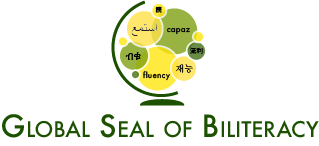November
GLOBAL CLASSROOM PAIR – SHARE - What does it look like?
The Global Seal will be pairing classrooms around the world to provide language learners with an opportunity to use their growing language skills to learn about one another and to work together as global citizens to create shared projects.
Partnered educators will plan their activities and organize their collaboration. If possible, students from collaborating schools (with their teachers), organize online meetings to create project products synchronously. If the time difference makes it impossible to meet, the activities are designed so that paired classrooms can work asynchronously as well.
In addition to each month's theme-related Content Goals, we have included Language Goals. Use "Content Goals" to engage the interest of your language learners, while intentionally thinking about "Language Goals" or how the tasks will also build and grow language proficiency.
It is important that paired classrooms document their projects. Take pictures during meetings or when your students are carrying out the tasks. Add a post to our Facebook page - show others how you are doing! It will be inspirational and motivating for others!
Explore our technology resources list to support your creative project ideas.
Please remember to protect the privacy of your students. Do not share their full names or other identifying information. Be sure you have permission if you share student images or likenesses.
November GOALS & ACTIVITIES
November’s Theme: “What’s in a book?”
November’s Goal: The goal for our second month is literacy. November’s activities are connected to books and reading. Together, you will create a common product. As you plan your shared projects, consider your variables, the time difference between your paired classrooms as well as the age and level of your students.
SHARE – Paired Classroom Activity
Prepare students for this month’s activities by thinking about your favourite books. In advance, prepare a few words about your favourite books, consider what your students will be able to do at their level.
Primary level students can take pictures of their favourite books and create an online book-covers exhibition. Students can create one or two lines about each book in text or speech.
Students can draw, paint or design an alternate cover for their favourite book and then prepare a short video with all.
COMPARE– Paired Classroom Activity
Students in each classroom can choose an age-appropriate popular book to share with their Paired Classroom. Students in each classroom can read both books and create a T-Chart or Venn Diagram comparison.
Have students find recipes or foods mentioned in different books and create a cookery recipe book. For students at lower levels of language learning, they can identify and list ingredients and determine if they would or would not like the recipe based on its ingredients. More advanced students can research a recipe and summarize what they learn. If possible, students can prepare a dish and add pictures to your project.
PREPARE
As a class (or with your Paired Classroom), create your own book. Come up with an interesting topic, write the text, add illustrations and don’t forget about a cover. If you have artistically gifted students, create a competition in which the students are the ones to choose the best cover.
Have your Paired Classroom prepare a magazine-style article or blog post telling others why it is important to read books. Together, prepare a text and add pictures of people reading books.
Discover where certain book plots are located. Create a map with these places. Add a short info about your book (author, title, short description).
DECLARE
Have students find a book in your target language, read it, and record a short review.
Collaboratively, students can prepare an article or presentation about why it is important to read books. For your project, prepare the text and add pictures of people reading books.
Create a graphic organizer or sequence picture to retell a story. Do not add written words; students will use the images as prompts and reminders as they retell the story (video, Flipgrid, etc.) or to summarize the book.
DARE
Contact a book author and organize an in-person or virtual meeting with them and your students. Students can ask questions and then present in writing or speech what they learned.
Language Goals for November – This focus of this month’s language tasks is literacy which may be understood as reading and writing, but also includes an opportunity to interpret cultural content that is unique to an author or a particular style of literature. When students read in a second language, they learn more than vocabulary, they also gain comprehension of how words are put together, are exposed to a variety of texts, and learn about another culture. They learn to interpret meaning through context and gain inference skills.
Reading also provides additional opportunities to level-up language skills. In retelling a story or discussing a book, students can summarize, learn to use sequencing words to describe a series of actions, can practice different time frames (what happened in the past, what is happening now, and what will happen in the future). More advanced students can hypothesize about what might happen or could have happened if the characters made a different decision. All students can describe, compare and contrast the characters in a story, discuss main idea, etc. Students can role-play a character and use the interpersonal mode of communication to ask and answer questions.
Click here to review our netiquette policies.






